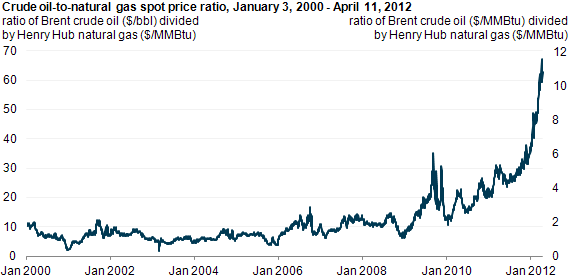
Price ratio of crude oil to natural gas continues to increase

Notes: $/bbl is dollars per barrel. $/MMBtu is dollars per million British thermal units. The crude oil-to-natural gas spot price ratio is calculated by dividing the spot price of Brent crude oil by the spot price of natural gas at the Henry Hub. In the past, the crude oil price most used for this calculation was West Texas Intermediate (WTI). Due to the current discount of WTI relative to Brent and other crude benchmarks, the Brent price is used here.
The ratio between the spot prices of crude oil and natural gas has been generally increasing since January 2009, but it has climbed rapidly in recent months (see chart). Analysts calculate the ratio in different ways to assess the value of crude oil relative to natural gas; two methods are shown in the chart above. The ratio increased because of both increasing crude oil prices and decreasing natural gas prices. The crude oil-to-natural gas spot price ratio has implications for production and consumption.
The spot price for Brent crude oil has increased 19% in the last six months, from $103.90 per barrel on October 3, 2011 to $123.81 per barrel on March 30, 2012. Several factors underpin the increase in global crude oil benchmarks since the start of the year. Over the same period, the spot price for natural gas at the Henry Hub has decreased 45%, dropping from $3.57 per million British thermal units (MMBtu) to $1.98/MMBtu. Natural gas spot prices have been near 10-year lows as a result of warmer-than-normal temperatures, ample natural gas in storage, and growing production.
In terms of production implications, a higher crude oil-to-natural gas ratio encourages drilling for oil in preference to natural gas and makes natural gas liquids developments relatively more attractive than the development of dry natural gas resources. On the consumption side, the higher ratio also encourages end users to choose natural gas over products derived from crude oil, such as distillate and residual fuel oil, wherever substitution is feasible.